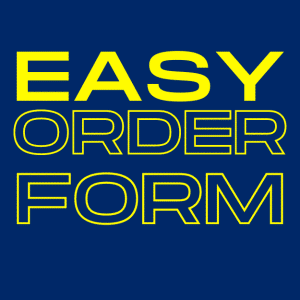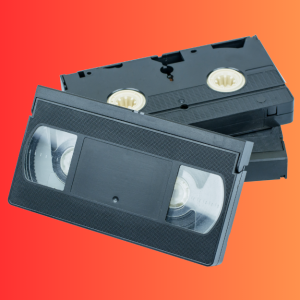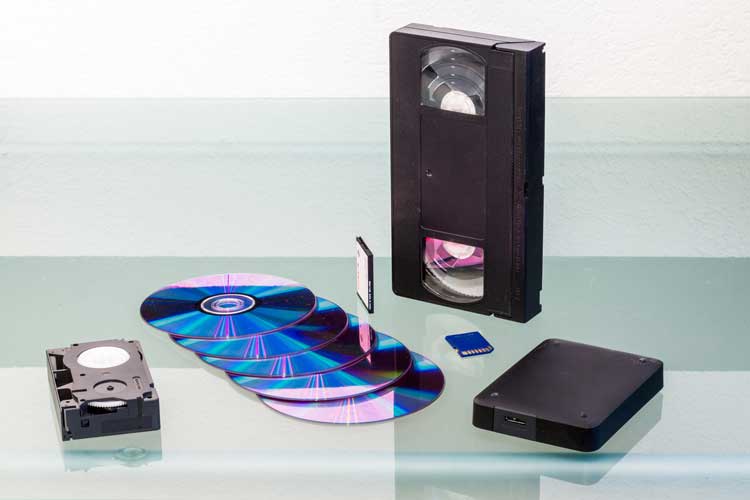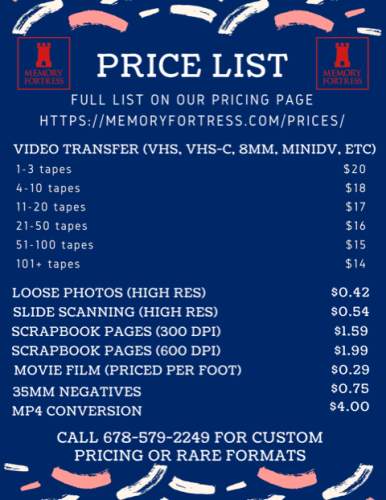Preserve Your Memories With Our Photo Scanning & Video Transfer Services
At Memory Fortress, we offer a wide range of services to help you protect your essential memories and keep them safe for future generations.
From photo scanning and video transfer to secure cloud storage, our team of experts will work with you to preserve your memories in a way that suits you best.
Memory Fortress: Preserving Precious Moments In Time
Welcome to Memory Fortress, where every memory is a treasure worth preserving.
In the digital age, the importance of keeping memories alive has soared to unprecedented heights.
Preserve your memories with our unparalleled photo scanning and video transfer services.
The Time Is Now To Safe Guard Your Family Memories
Easy Process
Most customers use the bright red “Order Now” button on the upper right side of the page to begin the process. When complete, you will receive an email with shipping instructions. Please follow the instructions and place the email in your box!
- Organize – Customer organizes memories to the best of their abilities.
- Ship – UPS or FedEx preferred. You pay the shipping to us; Memory Fortress pays all return shipping back to you.
- Processing Time – Most orders take no more than five business days to complete.
- Payment – The balance is due when we finish and invoice you via email. Click to pay! Or read a card over the phone.
- Happiness – Enjoy your memories on USB flash drives, the cloud, or DVDs!
Prices
A small deposit is taken upfront in the order flow; the remainder is due at the end of the process upon invoicing.
- 1-3 tapes – $20 apiece
- 4-10 tapes – $18 apiece
- 11-20 tapes – $17 apiece
- 21-50 tapes – $16 apiece
- 51-100 tapes – $15 apiece
- 100+ tapes – $14 apiece
- MP4 conversion – $4 apiece (optional, but required for USB flash drive and cloud deliveries)
The full pricing page is HERE.
What Makes Us Qualified?
-
In business since 2015, customers in all 50 states
-
Tens of thousands of videotapes converted to digital format
-
Millions of feet of movie film converted to digital format
-
Millions of photos and slides converted to digital format
-
The best equipment in the industry
-
The best people in the industry
-
Satisfaction is guaranteed
-
4.9 star rating on Google
-
Preferred partner of Heirloom
-
5 Business Day Turnaround Policy
-
We Answer The Phone!
-
We Respond To Your Emails!
-
We Don’t Participate in the Prepaid Box Scam!
Photo Scanning: A Glimpse Into The Past
Photos capture fleeting moments, freezing time in a frame. Yet, as time progresses, these invaluable memories can fade.
With our state-of-the-art photo scanning services, we delve into digital preservation, ensuring that every cherished memory is saved for generations to come.
Image scanning and photo digitization have become essential today, where old photo scanning is not just a service but a need.
At Memory Fortress, we pride ourselves on our expertise in scanning photos reviving those golden moments.

The Best Video Transfer Service: Relive Every Moment
Our video transfer service has revolutionized how we store and view our favorite moments.
The days of bulky tapes are over. With our digital transfer expertise, we can convert video mini DV tapes, be it videotape formats – VHS to digital or other formats, ensuring top-notch video file conversion.
From transferring old video tapes to intricate video digitization, we’ve got you covered.
Customer Testimonials
“Memory Fortress transformed my grandmother’s old photos into brilliant digital copies. Their photo digitizing service breathed life into our family memories!”
My wedding VHS tape, once deemed lost, was flawlessly transferred to a digital file format by Memory Fortress. Their VHS conversion technique is impeccable!”
Affordable Photo Scanning And Video Transfer Services
Our Specializations
- Photo and video digitization: Every photo and video format is treated carefully.
- Digital format conversion: Whether it’s a USB drive, digital storage, or digital download, we convert memories to your preferred medium.
- Old photo restoration: Preserve old photos and save them from the ravages of time, floods, fires, storms, and decay. Our old photo digitization process ensures that every image is returned to life.
- Slides to digital: We expertly convert slides and offer a comprehensive slide scanning service.
- Film to digital: From 8mm film digitization service to movie digital video conversions, our professionals ensure every frame is captured.
We Help You Keep The Memories
For Many Generations
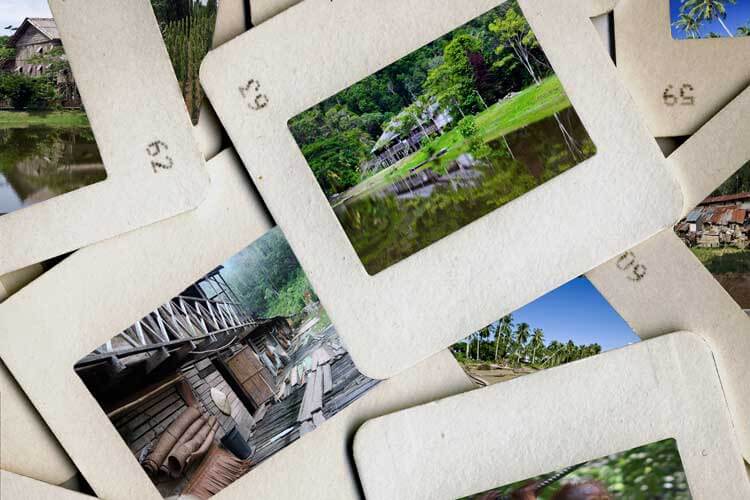
Slide Scanning
We talk to people daily who have discovered boxes of old slides from vacations and special occasions that were generations ago. Let us help you bring those precious times back to life in a shareable format.

Negative Scanning
If you have slides in a box somewhere, chances are good that you also have sleeves of negatives. This is your family history. Let us help you share the love of the generations. We’ll bring your memories to life. Call today.

Photo Scanning
We can take that photo box and turn it into a digital format. We carefully and lovingly place all your memories on a DVD or USB flash drive. This makes reminiscing and sharing easier.

Video Transfer
Remember those old home movies? We can digitalize them on a DVD or large-capacity flash drive. You make the popcorn, and we’ll get your old movies ready to share again.
The Process
It's Easy To Transfer Movie Film, Videotapes, Old Photos, And Slides To Digital

Place Your Order
- No need to count or sort.
- Ship your materials to Memory Fortress.

We Scan & Review
-
Quality digitization in just five days.
-
We crop, rotate, and color-correct all images.
-
We remove dust and minor blemishes.

Fast, Safe, Convenient
-
We ship your originals and new digital memories.
-
All packages are tracked, and we back up all files.
-
Turnaround time is five business days for most orders.

Share & Enjoy
- Share your new USB flash drive and DVDs
- You can also download from Dropbox
- All digital files can be shared easily on all platforms
Why Choose Memory Fortress?
- Experience: With years of digitizing experience, our team of experienced professionals ensures the best digitizing process for each memory.
- Versatility: Whether it’s a DVD or thumb drive, cloud storage, or digital backup, we offer various storage options.
- Customer Satisfaction: Our commitment to customer satisfaction is unparalleled. The positive feedback and high ratings we receive are a testament to our dedication.
Here are some other reasons to give Memory Fortress a call: (678)579-2249
- The most affordable rates in the industry
- The fastest turnaround times
- Dedicated to preserving your history
Call our staff today, and let’s talk about how easy it is to get your memories converted to a format that will last forever.
Call Us Today & Place Your Orders
![]() (678)579-2249
(678)579-2249

Old VHS Tapes To DVD Transfer Is A Gift For Generations
Wondering what to give your adult kids for Christmas?
How about digitizing those home movies from when they were kids?
Many people with adult children love to see their childhood memories again.
It’s even more fun when there are grandkids involved.
Imagine the conversations you’ll have and the memories you’ll share as you get together to see all those old pictures.
It allows you to tell the stories no one’s heard in years.
Your family deserves to be preserved.
Place an order to convert your old memories, including photographs, MiniDVs, and photo negatives, to digital media now, or give a gift card to someone special.
You’ll be glad you did.

Keith Osbon
Founder/President
Keith Osbon is the founder and President of Memory Fortress.
He has been passionate about preserving his family’s history and launched the company in 2015 to address the vital need that all Americans have.
Before Memory Fortress, Keith worked as a senior executive in digital analytics, starting in 2009.
A former Army captain, he began his post-military career in 1997 as a quantitative money manager for Goldman Sachs and JP Morgan.
Keith has a BA from Duke University and an MBA from the University of Georgia.

Dustin Williams
Office Administrator
Dustin Williams is the Office Administrator at Memory Fortress. He helps oversee the business’s daily operations, assures the high quality of our work, and maintains customer satisfaction.
At Memory Fortress, Dustin ensures that your family’s memories are handled with the same utmost care and consideration he would desire for his family memorabilia.
Dustin has over eight years of experience in customer service, including his time as a Front Desk Supervisor at Hyatt Regency Atlanta.

Lori Griggs
Creative Director
Lori Griggs is the Creative Director for Memory Fortress.
She has been with the company since its inception in 2015 and has focused on photo scanning and old documents.
Lori is an avid researcher, and much of our initial equipment came from her recommendations and purchases.
In addition to her contributions to Memory Fortress, she is a talented painter.
She has a BFA from Georgia Southwestern University.
Securing Memories Against Time
The unpredictability of life, with threats like floods, fires, storms, and decay, can endanger our precious memories.
At Memory Fortress, we emphasize the need to protect memories. Our mission is not just to safeguard photos but to ensure that these moments remain vibrant, accessible, and immune to the passage of time.
Our digitizing service is trusted by thousands who have witnessed the magic we bring to old media. With us, your memories aren’t just memories; they are legacies.
Preserving Emotions, Stories, and Legacies: Welcome to Memory Fortress
At Memory Fortress, memories aren’t just images or home videos but emotions, stories, and legacies.
We understand the profound value of family memories, the nostalgia of old photos, and the joy in home movies. We promise to provide exceptional service that ensures you can keep memories forever.
Dive into the world of digital preservation with Memory Fortress, and let us help you relive all your precious family memories. Welcome to a fortress where memories are cherished, preserved, and celebrated.
Memory Fortress: Expertise In VHS To DVD Conversion
In an age where digital media reigns supreme, the charm of classic videotapes remains unparalleled. However, as time progresses and technology advances, the need to safeguard and update these precious memories becomes vital. Welcome to Memory Fortress, where we specialize in VHS tape-to-DVD conversion service, ensuring your treasured moments are preserved and revitalized.
The Charm Of VHS Tapes In A Digital Age
VHS tapes, for many, are a nostalgic treasure trove of memories. From birthdays to weddings, these tapes captured countless memorable moments. However, VHS tapes, like all physical media, are susceptible to wear and tear. That’s where our video tape transfer service steps in, ensuring that your memories are not lost to the ravages of time.
Why Convert VHS To DVD?
VHS to DVD transfer service is more than just a conversion process; it bridges the past and the present. DVDs, being a digital format, offer several advantages:
- Longevity: DVDs are more durable and have a longer lifespan than VHS tapes.
- Quality: Preserve the original quality of your video tapes, preventing further degradation.
- Accessibility: DVDs are easily accessible and can be played on numerous devices, ensuring your memories are always at your fingertips.
Preserving The Past, For The Future
Digitizing isn’t just about converting a format; it’s about preserving emotions, moments, and stories. At Memory Fortress, we pride ourselves on safeguarding your memories. With each VHS tape to DVD conversion, we ensure a piece of the past is cemented for future generations.
Choose Memory Fortress: Where Memories Live On
The essence of our service lies in our dedication, expertise, and love for memories. We understand the emotional value behind each VHS tape, and our service to transfer VHS to DVD is tailored to honor that sentiment.
Embark on a journey with Memory Fortress, where your memories are not just digitized but celebrated. Choose us, and let your cherished moments shine brightly in the digital age.
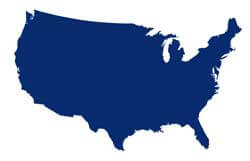
We Serve All Of The United States
It is our pleasure to serve all 50 States.
Our customers rely on us to deliver a top-quality product that is affordable with a fast turnaround time.
When you need to convert 35mm film 8mm camcorder videos into the latest digital formats, USB or DVDs, we hope you will choose Memory Fortress.
Visit the order form here when you are ready. > Order Now!
Call us today to place your order: 678-579-2249
Send us a message below if you need additional information.
Nationally
People in every state have trusted the dedicated staff at Memory Fortress with their precious memories.
Alabama Arizona Alaska Arkansas California Colorado Connecticut
Delaware Florida Georgia Hawaii Idaho Illinois Indiana
Iowa Kansas Kentucky Louisiana Maine Maryland Massachusetts
Michigan Minnesota Mississippi Missouri Montana Nebraska Nevada
New Hampshire New Jersey New Mexico New York North Carolina
North Dakota Ohio Oklahoma Oregon Pennsylvania Rhode Island







